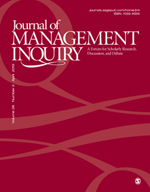 Business and Management INK
Business and Management INK Should Everyone Have a Work Spouse?
[Ed. Note: The blog Business and Management INK, which for years has presented insights drawn from academic papers appearing in SAGE Publishing’s top-flight journals on business and management, is re-locating to Social Science Space. We are currently preparing a home for past INK content while posting new material.]
Marilyn Whitman of the University of Alabama and Ashley Mandeville of Florida Gulf Coast University sat down with SAGE Publishing to discuss their work on the article, “Blurring the Lines: Exploring the Work Spouse Phenomenon,” which was recently accepted into SAGE’s Journal of Management Inquiry.
Below, they share a little bit more about their motivations, insights, methods, and the underpinnings of their research.

Why did you pursue research on the work spouse?
Our motivation to explore the work spouse phenomenon stemmed from our own personal experiences. I first heard the term “work husband” about a decade ago when actress Leah Remini used it to refer to Kevin James, who played her on-screen husband on the long-running sitcom King of Queens. I remember being so intrigued by the term, mostly because it finally provided a term to describe my own close bond at work. Years later, I happened to mention the term to my co-author and she was equally as intrigued having experienced a similar bond herself.
As we scoured the literature, we stumbled on dozens of popular press articles featuring real life work spouses. Yet there was little to no discussion of work spouses in the academic literature. Having experienced both positive and negative outcomes as a result of our work spouse relationships, we thought it was time to introduce the work spouse phenomenon as a workplace relationship worthy of scholarly attention.
Tell potential readers a little bit about the essay.
Our essay touches on individuals’ psychological need to develop and maintain strong emotional bonds. What didn’t make it into our manuscript due to space constrains was that humans, in addition to the psychological motivations, are also biologically and genetically motivated to form close bonds with others. In fact, our need to bond is so innate that we begin to form bonds as early as infancy. Scientists have identified a number of neurotransmitters, such as oxytocin, vasopressin, and dopamine, linked to the bonding process. Developing close bonds with others increases positive attitudes, promote prosocial behaviors, and even have an addictive effect as individuals experience a feeling of euphoria (oxytocin is commonly referred to as the “love hormone”).

Our desire to further understand the underpinnings of human bonding behavior led us to prairie voles. A relative of the mouse, these small furry rodents surprisingly have a lot in common with humans which is why behavioral scientists have turned to voles in an effort to understand human bonding behavior. Prairie voles display socially monogamous behavior, bi-parental care of offspring, and depressive-like behavior when a partner is lost. Scientists have been able to link factors such as social recognition, affiliative behavior, mate guarding, social buffering, and negative affect as a result of separation to the formation and maintenance of bonds.

What was most interesting to us, and central to the work spouse phenomenon, was that prairie voles were able to form close bonds that didn’t involve the act of mating. That is, mating is not necessary for partner preference selection or the formation of a pair bond. This finding is particularly significant when generalized to human bonding behavior, as it lends credence to the argument that a work spouse is not akin to a workplace romance.
What do you hope will come out of the essay?
Moving forward, our hope is that our essay sparks the same degree of intrigue in others as it did for us. There is much to learn about the individual and contextual factors that influence the development and maintenance of work spouse relationships, as well as the consequences for the work spouse pair, the organization, and the bystanders in both the work and personal domains

























































































